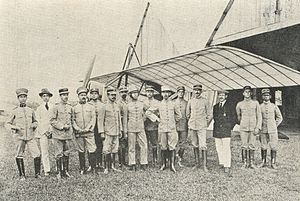Contestado War
| Contestado War | |||||||
|---|---|---|---|---|---|---|---|
 Aviation of the Brazilian Army in the Contestado War, in 1915. |
|||||||
|
|||||||
| Belligerents | |||||||
|
|
|||||||
| Commanders and leaders | |||||||
|
|
|
||||||
| Strength | |||||||
| 10,000 rebels | 7,000 soldiers 1,000 local police 1,000 militiamen 3 aircraft |
||||||
| Casualties and losses | |||||||
| 5,000 – 8,000 dead, wounded or disappeared | 800 – 1,000 dead, wounded, deserted or disappeared | ||||||
The Contestado War (Portuguese: Guerra do Contestado), broadly speaking, was a guerrilla war for land between settlers and landowners, the latter supported by the Brazilian state's police and military forces, that lasted from October 1912 to August 1916.
It was fought in an inland southern region of the country, rich in wood and yerba mate, that was called Contestado because it was contested by the states of Paraná and Santa Catarina as well as Argentina. The war had its casus belli in the social conflicts in the region, the result of local disobediences, particularly regarding the regularization of land ownership on the part of the caboclos. The conflict was permeated by religious fanaticism expressed by the messianism and faith of the rebellious caboclos that they were engaged in a religious war; at the same time, it reflected the dissatisfaction of the population with its material situation.
...
Wikipedia
